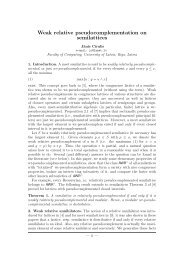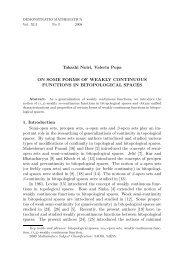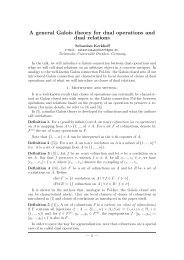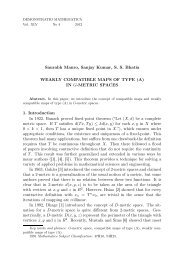Finite segments of the harmonic series
Finite segments of the harmonic series
Finite segments of the harmonic series
You also want an ePaper? Increase the reach of your titles
YUMPU automatically turns print PDFs into web optimized ePapers that Google loves.
From <strong>the</strong> immediately preceding two sets <strong>of</strong> inequalities we get that<br />
1 1<br />
−<br />
m + k − 1 m ′ < ln(1 + k′ − 1<br />
m ′ k − 1<br />
)/(1 +<br />
m ) + σ − σ′ ,<br />
where σ and σ ′ are shorthand for σ(m, k) and σ(m ′ , k ′ ), respectively.<br />
Recall that σ − σ ′ ≤ 0. Since m + k ≤ m ′ , we have that<br />
Therefore<br />
0 < L :=<br />
The lemma follows.<br />
1 1<br />
−<br />
m + k − 1 m ′ < ln(1 + k′ − 1<br />
m ′ )/(1 +<br />
1 < e L < (1 + k′ − 1<br />
m ′ )/(1 +<br />
1 + k′ − 1<br />
m ′<br />
k − 1<br />
) , whence<br />
m<br />
k − 1<br />
> 1 +<br />
m .<br />
Theorem 11. Let m < k. Then σ(m, k) = σ(m ′ , k ′ ).<br />
k − 1<br />
) .<br />
m<br />
Pro<strong>of</strong>. Lemma 10 gives us that 1 ≤ (k−1)/m < (k ′ −1)/m ′ . So m ′ < k ′ −1<br />
whence σ(m, k) = σ(m ′ , k ′ ) by Theorem 9.<br />
Corollary 12. Let σ > 1/m + ln 2. Then σ ′ = σ.<br />
Pro<strong>of</strong>. In our pro<strong>of</strong> <strong>of</strong> Lemma 10 we saw that σ < 1/m+ln(1+(k −1)/m).<br />
So 1/m + ln 2 < σ < 1/m + ln(1 + (k − 1)/m) by hypo<strong>the</strong>sis. It follows that<br />
ln 2 < ln(1 + (k − 1)/m). Thus m < k − 1. So σ ′ = σ by Theorem 11.<br />
Given 〈m, k, m ′ 〉 ∈ N 3 , recall that k ′ is determined, and that if<br />
σ(m ′ , j) = σ(m, k) <strong>the</strong>n j = k ′ . By Theorem 11, σ(m ′ , k ′ ) = σ(m, k)<br />
when <strong>the</strong> interval [m, m + k) is “long”; i.e., when m < k. Theorem 8<br />
implies that for no m is <strong>the</strong>re a 〈m ′ , k ′ 〉 such that σ(m ′ , k ′ ) = σ(m, 1).<br />
We have not established <strong>the</strong> injectivity <strong>of</strong> σ for 2 ≤ k ≤ m. But we<br />
now show that, for each m, <strong>the</strong>re are at most finitely many m ′ > m for<br />
which <strong>the</strong> possibility σ(m ′ , k ′ ) = σ(m, k) will not yet have been eliminated.<br />
Theorem 13. Let k ′ ≥ 2(m + k). Then σ(m ′ , k ′ ) = σ(m, k).<br />
6








